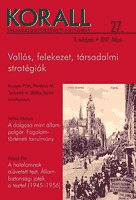Görög és római katolikus nemzetiségek házasságainak jellemzői Torna megyében a 19. század közepén
Characteristics of the marriages of Greek and Roman Catholic ethnic groups in Torna county in the mid-19th century
Author(s): Péter Pozsgai Subject(s): History
Published by: KORALL Társadalomtörténeti Egyesület
Summary/Abstract: The preserved nominal documentations of the mid-19th century censuses are the most important out of the archive sources of Torna county: the listings of the 1850 census and the house-registers of the 1869 census. The registers of the census of 1869 indicate the names of the family-members and each co-residing members of the house who were present at the moment of the census. The register consisted of the following data about each member of the household: gender, marital status, year of birth, religious denomination, occupation, residence, presence and absence, birthplace and literacy-level. A nominal-level database could have been established based on the nominal household registers of the 1869 census, extended to 37 villages and one market-town (21.000 persons). With the use of the detailed census data the marriages can also be examined in local and regional level as well (local endogamy/exogamy, ethnic-denominational homogamy/heterogamy). There was no column for the ethnicity on the sheets of the 1869 census survey, so by relying on the preserved results of the 1850 census and some complementary sources the ethnic composition of the two districts could have been revealed. The proportion of the Hungarians was similarly high in both of the Upper and Lower districts (84% and 86%), that is, after the settlement and immigration of the Poles, Ruthenes (Rusyns) and Slovaks in the 18th century the predominantly Hungarian character of the region remained unchanged. There were altogether two settlements with mixed ethnic groups in the mid-19th century: in Barakony besides the Ruthenian inhabitants (141 heads) there were 108 Hungarians, in Rákó besides the 309 Slovak heads 72 persons confessed themselves Hungarian. Mainly in the 18th century settled the Poles in Derenk, the Ruthenians in Horváti and the Slovaks in Szentandrás which had remained as homogeneous ethnic groups till the mid-19th century. The only exception is Falucska where the vlach Ruthenian settlers arrived in the 15th century. The comparison of the ethnic data of the 1850 and 1881 censuses confi rmed the necessity of correcting the 1881 census in this fi eld, and it proved the inadequacy of the language-based ethnic listings for revealing the real dimensions of the ethnic groups and minorities. The ratio of religious denominations of the population in Torna county can be determined from the nominal census registers. The Roman Catholic and the Reformed (Calvinist) Churches were dominant in both of districts, altogether they represented 88% in the Upper District and 92% in the Lower District. In the Upper District 59% of the inhabitants belonged to the Roman Catholic church, 29% to the Reformed Church, while in the Lower District the ratio of the reformed was 51%, the Roman Catholic 41%. In the Upper District the number of Uniates (Greek Catholic Church) was relatively high (7%), who were predominantly Ruthenes of Falucska and Horváti. In the Lower District the Ruthenes were belonged to the
Journal: Korall - Társadalomtörténeti folyóirat
- Issue Year: 2007
- Issue No: 27
- Page Range: 45-93
- Page Count: 49
- Language: Hungarian

